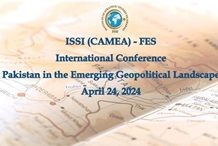Dream comes true and it is an Asian dream because it is an Asian century. Another Asian bank has been established after the Asian Development Bank (ADB), which came into being in Manila in 1966 under Japanese leadership. The new Asia Investment and Infrastructure (AIIB) is the result of the Chinese efforts and the bank was set up on 24 October 2014 at Beijing. It should be re-called that it was first Pakistan, which was being consulted when Japan thought of setting up such a bank for Asian trade, investment and development. Ever since, Pakistan got a promising relationship with the ADB.
After World War II, Asian lending turned into a quagmire. All attention was focus on European reconstruction. United States made the Marshall Plan for Europe in 1947 and provided funds worth US$ 17 billion for the contraction of the war-devastated regions in Europe. Asia was neglected as it was their second priority with Japan as the starting point. Japan used to be the only hope in Asia. With Japanese economic and industrial recovery in the 1960s, the fate of Asia began to change. Japan largely invested in Asia and by lending, it created better economic opportunities. Thus Japan became a role model for East Asian economic surge. The purpose of the payment of war reparations by Japan was to build Asian economies. Japan paid such reparations up to US$ 1.5 billion. It was a huge contribution those days.
Similarly, today it is AIIB. Like the ADB, its creator, China, deeply consulted with Pakistan to establish this bank and like ADB, Pakistan became the one of founding members of the AIIB. Moreover, when ADB was created, West got suspicious about Japan’s role as confidence was not much restored between Japan and the United States and European countries but the bank has performed so well under the dynamic leadership of Japan. Asian poverty was addressed. The phenomenon of the East Asian Tiger Economies and New Industrialized Economies (NIEs) became possible under ADP.
Japan’s economic status has been replaced by China in 2010. It is now the second world’s economic power after the United States as Japan used to be. China matters in today’s world economy as per its political wisdom. Developing countries in Asia and Africa have much hope in the Chinese economic model and wisdom. China has been emerging as a lender and as an investor. So the need of a bank was greatly felt. China has played an important role in ASEAN development as its Dialogue Partner along with Japan and South Korea.
After the Shanghai Cooperation Organization (SCO) and broader stakes in the organization, Bao Economic Forum, and the formation of the BRICS (Brazil-Russia-India-China-South Africa), China realized the need to establish AIIB for greater Asian economic integration and to lessen reliance on Western lending institutions such as the World Bank and International Monetary Fund (IMF) that come up with their own pre-conditions and political manipulations to get control over the national institutions and policies detrimental to their causes.
So the AIIB is a promising an addition to the existing lending, investment, infrastructure development, and trading causes in Asia. China would assist and lend Asian countries to build their projects. This would also enhance the existing role of China as an economic power. Economic good governance would be the main aim of the AIIB.
The bank would provide to build new infrastructure in Asia as China wants to build new economic corridors in Asia such the Silk Route Belt in Central Asia, China-Pakistan Economic Corridor (CPEC), and the China-India-Bangladesh-Myanmar (CIBM) Economic Corridor. These are energy and trade corridors mutually beneficial to these countries. China would provide a leadership role in building these corridors to uplift the infrastructure in Asia, hitherto neglected for centuries. The AIIB would play a central role with China as an initial capital investor of US$ 50 billion to establish this bank. China would increase the authorized capital to US$100 billion and with that amount the AIIB would be two-thirds the size of the ADB.
Along with China the founding members of the bank are: India, Thailand, Malaysia, Singapore, the Philippines, Pakistan, Bangladesh, Brunei, Cambodia, Kazakhstan, Kuwait, Laos, Myanmar, Mongolia, Nepal, Oman, Qatar, Sri Lanka, Uzbekistan, and Vietnam. Unfortunately, Indonesia stayed away as a founding member but as a country to create awareness about Asian integration by convening the Bandung Afro-Asian Conference in 1955, it is hope that Indonesia will soon join the bank and actively participate in its activities. China plays an important role in ASEAN and the absence of Indonesia would greatly felt. Technically, Japan and South Korea would not afford to stay away from the AIIB. Australia cannot do trade without China in Asia and would be badly needed to cooperate with the AIIB. Hence, the acceptability of the AIIB would be greater than it is realized at present.
It is hope that instead of contesters, ADB and AIIB should cooperate with each other in building infrastructure, expanding investment, and promoting trade as Asian financial and economic woes are myriad. In short, China made a major breakthrough in ending the Western financial institutions’ hegemony in Asia. With AIIB establishment, it would be possible to lay down the foundation of the new economic order in Asia and developing countries for which many Asian leaders struggled hard from Bhutto to Boumediene and from Mao Dezong to Xi Jinping.
Views expressed are of the author and do not necessarily reflect the views of ISS or of the Government of Pakistan.












